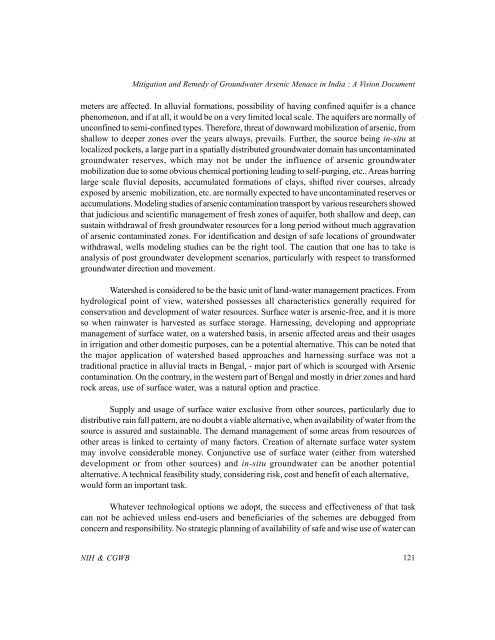Mitigation and Remedy of Groundwater Arsenic Menace in India
Mitigation and Remedy of Groundwater Arsenic Menace in India
Mitigation and Remedy of Groundwater Arsenic Menace in India
You also want an ePaper? Increase the reach of your titles
YUMPU automatically turns print PDFs into web optimized ePapers that Google loves.
<strong>Mitigation</strong> <strong>and</strong> <strong>Remedy</strong> <strong>of</strong> <strong>Groundwater</strong> <strong>Arsenic</strong> <strong>Menace</strong> <strong>in</strong> <strong>India</strong> : A Vision Documentmeters are affected. In alluvial formations, possibility <strong>of</strong> hav<strong>in</strong>g conf<strong>in</strong>ed aquifer is a chancephenomenon, <strong>and</strong> if at all, it would be on a very limited local scale. The aquifers are normally <strong>of</strong>unconf<strong>in</strong>ed to semi-conf<strong>in</strong>ed types. Therefore, threat <strong>of</strong> downward mobilization <strong>of</strong> arsenic, fromshallow to deeper zones over the years always, prevails. Further, the source be<strong>in</strong>g <strong>in</strong>-situ atlocalized pockets, a large part <strong>in</strong> a spatially distributed groundwater doma<strong>in</strong> has uncontam<strong>in</strong>atedgroundwater reserves, which may not be under the <strong>in</strong>fluence <strong>of</strong> arsenic groundwatermobilization due to some obvious chemical portion<strong>in</strong>g lead<strong>in</strong>g to self-purg<strong>in</strong>g, etc.. Areas barr<strong>in</strong>glarge scale fluvial deposits, accumulated formations <strong>of</strong> clays, shifted river courses, alreadyexposed by arsenic mobilization, etc. are normally expected to have uncontam<strong>in</strong>ated reserves oraccumulations. Model<strong>in</strong>g studies <strong>of</strong> arsenic contam<strong>in</strong>ation transport by various researchers showedthat judicious <strong>and</strong> scientific management <strong>of</strong> fresh zones <strong>of</strong> aquifer, both shallow <strong>and</strong> deep, cansusta<strong>in</strong> withdrawal <strong>of</strong> fresh groundwater resources for a long period without much aggravation<strong>of</strong> arsenic contam<strong>in</strong>ated zones. For identification <strong>and</strong> design <strong>of</strong> safe locations <strong>of</strong> groundwaterwithdrawal, wells model<strong>in</strong>g studies can be the right tool. The caution that one has to take isanalysis <strong>of</strong> post groundwater development scenarios, particularly with respect to transformedgroundwater direction <strong>and</strong> movement.Watershed is considered to be the basic unit <strong>of</strong> l<strong>and</strong>-water management practices. Fromhydrological po<strong>in</strong>t <strong>of</strong> view, watershed possesses all characteristics generally required forconservation <strong>and</strong> development <strong>of</strong> water resources. Surface water is arsenic-free, <strong>and</strong> it is moreso when ra<strong>in</strong>water is harvested as surface storage. Harness<strong>in</strong>g, develop<strong>in</strong>g <strong>and</strong> appropriatemanagement <strong>of</strong> surface water, on a watershed basis, <strong>in</strong> arsenic affected areas <strong>and</strong> their usages<strong>in</strong> irrigation <strong>and</strong> other domestic purposes, can be a potential alternative. This can be noted thatthe major application <strong>of</strong> watershed based approaches <strong>and</strong> harness<strong>in</strong>g surface was not atraditional practice <strong>in</strong> alluvial tracts <strong>in</strong> Bengal, - major part <strong>of</strong> which is scourged with <strong>Arsenic</strong>contam<strong>in</strong>ation. On the contrary, <strong>in</strong> the western part <strong>of</strong> Bengal <strong>and</strong> mostly <strong>in</strong> drier zones <strong>and</strong> hardrock areas, use <strong>of</strong> surface water, was a natural option <strong>and</strong> practice.Supply <strong>and</strong> usage <strong>of</strong> surface water exclusive from other sources, particularly due todistributive ra<strong>in</strong> fall pattern, are no doubt a viable alternative, when availability <strong>of</strong> water from thesource is assured <strong>and</strong> susta<strong>in</strong>able. The dem<strong>and</strong> management <strong>of</strong> some areas from resources <strong>of</strong>other areas is l<strong>in</strong>ked to certa<strong>in</strong>ty <strong>of</strong> many factors. Creation <strong>of</strong> alternate surface water systemmay <strong>in</strong>volve considerable money. Conjunctive use <strong>of</strong> surface water (either from watersheddevelopment or from other sources) <strong>and</strong> <strong>in</strong>-situ groundwater can be another potentialalternative. A technical feasibility study, consider<strong>in</strong>g risk, cost <strong>and</strong> benefit <strong>of</strong> each alternative,would form an important task.Whatever technological options we adopt, the success <strong>and</strong> effectiveness <strong>of</strong> that taskcan not be achieved unless end-users <strong>and</strong> beneficiaries <strong>of</strong> the schemes are debugged fromconcern <strong>and</strong> responsibility. No strategic plann<strong>in</strong>g <strong>of</strong> availability <strong>of</strong> safe <strong>and</strong> wise use <strong>of</strong> water canNIH & CGWB 121




